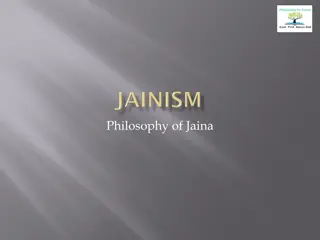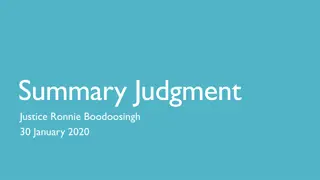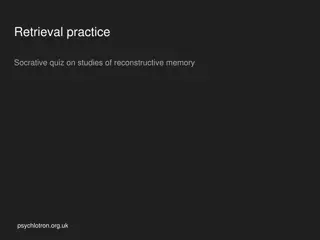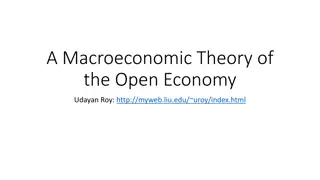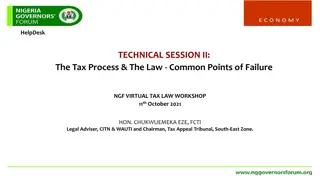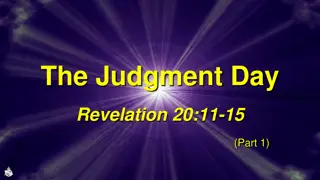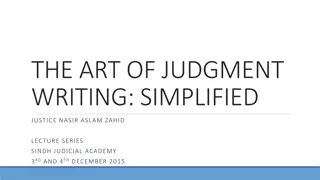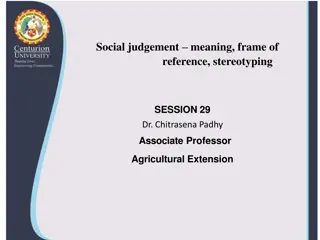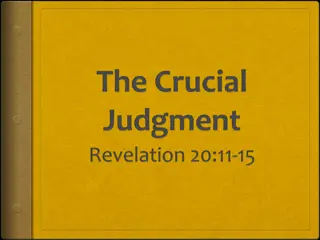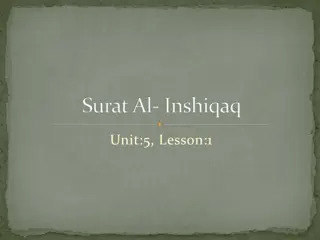Understanding Syadvada: Jain Theory of Judgment Explained
Syadvada, also known as the Jain theory of judgment, emphasizes the relativity of every judgment, based on the concept of Anekantvad in Jainism. According to this theory, every object has innumerable characteristics, both positive and negative. Judgments are considered relative, and complete knowledge of an object requires understanding all its aspects. The story of blind men and the elephant is often cited to illustrate the limitations of viewpoint in forming judgments.
Download Presentation

Please find below an Image/Link to download the presentation.
The content on the website is provided AS IS for your information and personal use only. It may not be sold, licensed, or shared on other websites without obtaining consent from the author. Download presentation by click this link. If you encounter any issues during the download, it is possible that the publisher has removed the file from their server.
E N D
Presentation Transcript
SYADVADA -By Dr. Ranjana Sharma Head Department of Philosophy Durga Mahavidyalaya, Raipur (C.G.)
Theory of Judgement Syadvada is also called as Jain theory of judgement. According to this theory every judgement is relative . It is based on Anekantvad of Jainism. Anekantvad means Anant Dharmakam Vastu . It means every object has innumberable characteristics.
How every objects has innumerable characters[Anant Dharmakam Vastu] Every object has positive and negative characters. Positive character for example, of a man is his size, his colour,shape,weight,family,race,nationality,education, employment,place of birth etc. Negative character of a man is the man consists of what he is not for example he is not Indian, he is not employed, he is not a poet etc. To know him completely [fully] we should know his positive and negative characteristics both, as he is Indian, Chinise, he is employed, not unemployed, he is an honest, not dishonest etc. not
As the negative characters of the man consists in his distinctions from all other objects in the universe, negative characters are far greater than positive characters. Positive and negative characters make an object of unlimited characters. If we take the element of time [Past, Present, Future]it becomes characters with infinite characters[Anant, Dharmakam, Vastu].
Objects have many characters Only an omniscient being [Kewali] can obtain [through Kevalya gyan] an immediate knowledge of an object with all its innumerable characters. But imperfect beings look at objects from one particular point of view at a time and have consequently the knowledge of only one aspect or character of the thing. Particular knowledge about one of the innumerable aspects [characters]of an object is called by Jain Naya . Judgement knowledge is also called a Naya . [pasamarsh] based on such particular
Every Judgment Is Relative Every judgment that we pass in daily life about any object is therefore, true only in reference to the standpoint occupied and the aspect of the object considered. Generally we forget this limitation and regard our judgments as unconditionally true. This is the main reason of quarrel and disagreement.
To clear their view they describe the story of blind men and elephant. The story of the blind men who formed their ideas of an elephant by touching its respectively and thus came to quarrel about the real shape of elephant. They quarreled because each thought that his knowledge was the only true and complete knowledge and should be accepted unconditionally. legs, ears, tail and trunk The quarrel was over as soon as each of them realized that his knowledge was only of one of the many parts of the elephant.
Every Judgment should be qualified by Syat Syat means the judgment is true in some respect [or somehow]. The limitation of the judgment and the possibility of other alternative judgments from other points of view may be always clearly borne in mind. So it is suggested for example instead of a judgment like The elephant is like a pillar ,it should be said , somehow [i.e.in respect of its legs, the elephant is like a pillar. In the same way , we should not say The jug exists but should rather say Syat[somehow] the jug exists. Syat reminds us that the judgment is true only with regard to the many conditions of space, time, quality etc.
Seven Forms Of Judgment Ordinarily , there are two kinds of judgment affirmative and negative. The Jains distinguish seven kind of judgment including these two- 1.Syat asti. 2. Syat nasti. 3. Syat asti cha nasti cha. 4. Syat avaktavyam. 5.Syat asti cha avaktavyam cha. 6.Syat nasti cha avaktavyam cha. 7.Syat asti cha nast cha avaktavyam cha.
Jains Theory Is Not Sceptic It is not the uncertainty of judgment. It has conditional or relative character which is expressed by Syat .




